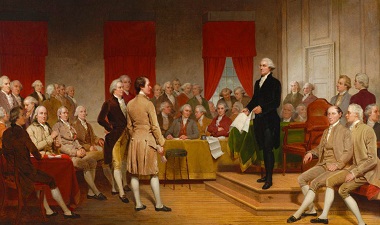
Getting Started
This module includes two Unboxing the Constitution videos (4 min and 6 min), two Inside the Constitution videos (5 min and 6 min), student activities, and a learning project. Download the Teachers Guide and the Student Content Guide for more details on content and implementation. Course materials are provided in Google documents, Word documents, as well as printable PDFs.
A preview of the module can be accessed below.
Topics covered include:
- The Constitutional Convention
- Learning about the Framers
- Understanding Compromise
- Ratification

Vocabulary
At the beginning of each module, students are presented with vocabulary words and definitions.
Concept Words
Concept words are conceptually related to the big ideas in what they’re learning. These connect directly to the core concepts or themes of the lesson or unit and help students grasp the main ideas and how everything fits together.
- compromise: a solution to a disagreement where both sides give up something
- convention: a gathering or assembly
- delegate: a person chosen to stand for others
- ratification: to officially approve
Speed Bump Words
Speed bump words are words that aren’t central to the concept being taught, but if students don’t understand them, they may struggle to comprehend the text or lesson. These words can help shape students' overall understanding of the topic.
- abolition: to stop an act or practice; for example, to end slavery
- consent: to agree or approve
- debate: a discussion between people on different sides of an issue
- influence: the power to have an effect on another person
- quorum: the fewest number of members in a meeting in order for it to do the necessary work

Topic 1: Writing a New Constitution
In 1786, politicians meeting in Annapolis, Maryland, called for a “general convention” in response to the disruptions taking place in and between the states. In 1787, the Confederation Congress finally agreed to this gathering of delegates.
4.1: Activate Prior Knowledge
To start engaging with the content in this module, students will collaboratively brainstorm prior knowledge about the Constitutional Convention.
Unboxing the Constitution
In this Unboxing the Constitution video, Lucy explores the events, ideas, and influential people that shaped the Constitutional Convention and the ratification process.
4.2: Convention Observations
Explore the Signing of the Constitution painting as a class. Students should consider what they notice, what questions they have, and who is present (and missing) from the painting. Explore the Teachers Guide for discussion questions and connections to the content in the rest of the module.
4.3: Meet the Players
Students will watch the Inside the Constitution videos and use the Video Notes (4.3.2) to learn about the men who were part of the constitutional creation, compromise, and signing process. Use this activity (4.3.1) to come to a consensus about the MVP of the Convention.
Inside the Constitution, Part I
Inside the Constitution, Part II
4.4: Closing Activity
Students will check in on the Key Question(s).

Topic 2: Understanding the New Constitution and Ratification
By the end of the Constitutional Convention, the framers of the Constitution had come to realize an important truth. The Constitution wasn’t perfect, but human beings aren’t perfect, either. As Benjamin Franklin famously said in his closing remarks at the Convention, now was the time to listen to others, be open to changing one’s mind, and come together to sign the Constitution.
4.5: The Necessity of Compromise
What is compromise and what makes it so important? Students will consider the need for compromise in different settings while participating in a civil dialogue. Use the Teachers Guide for strategies on how to facilitate this discussion with your students.
After the discussion, share this Unboxing the Constitution or further insight into the compromises that were part of the Constitutional Convention and the ratification process.
Love civil dialogue as much as we do at the NCC? Explore the Civil Dialogue Toolkit to learn even more approaches, methods, and practical application techniques.
4.6: Meet the Influencers
How would delegates from the Convention use social media today to convey their point of view? Students will create posts from some of the most influential men who were part of the Constitutional Convention to dive even deeper into their beliefs, while connecting them to practices from today.
4.7: Civic Connection: Compromise Workshop
In this Civic Connection activity, students will practice the art of compromise by finding solutions to familiar problems they experience today.
4.8: Reflect
To end this module, students will revisit the brainstorming and Key Questions from the beginning of the module to see how insights have grown throughout the lesson.

Learning Project: The Art of Persuasion Posters with Meaning
In this activity, students will create a poster that supports the Federalist or Anti-Federalist cause through historical arguments and compelling imagery to convey their messages. When students have completed their posters, they will share their completed designs in an in-person or virtual gallery walk.













